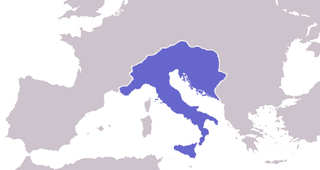
Amalasuintha was a ruler of the Ostrogothic Kingdom from 526 to 535. Initially serving as regent for her son Athalaric, she became queen after his premature death. Highly educated, Amalasuintha was praised by both Cassiodorus and Procopius for her wisdom and her ability to speak three languages. Her status as an independent female monarch, and obvious affinity for Roman culture, caused discontent among the Gothic nobles in her court, and she was deposed and killed after six months of sole rule.

Theodoricthe Great, also called Theodoric the Amal, was king of the Ostrogoths (475–526), and ruler of the independent Ostrogothic Kingdom of Italy between 493 and 526, regent of the Visigoths (511–526), and a patrician of the Eastern Roman Empire. As ruler of the combined Gothic realms, Theodoric controlled an empire stretching from the Atlantic Ocean to the Adriatic Sea. Though Theodoric himself only used the title 'king' (rex), some scholars characterize him as a Western Roman Emperor in all but name, since he ruled large parts of the former Western Roman Empire, had received the former Western imperial regalia from Constantinople in 497, and was referred to by the title augustus by some of his subjects.
The 430s decade ran from January 1, 430, to December 31, 439.
The 530s decade ran from January 1, 530, to December 31, 539.
The 500s decade ran from January 1, 500, to December 31, 509.
The 510s decade ran from January 1, 510, to December 31, 519.
The 520s decade ran from January 1, 520, to December 31, 529.
The 540s decade ran from January 1, 540, to December 31, 549.
The 490s decade ran from January 1, 490, to December 31, 499.
The 480s decade ran from January 1, 480, to December 31, 489.
The 450s decade ran from January 1, 450, to December 31, 459.

Year 450 (CDL) was a common year starting on Sunday of the Julian calendar, the 450th Year of the Common Era (CE) and Anno Domini (AD designations, the 450th year of the 1st millennium, the 50th year of the half of 5th century, and the 1st year of the 450s decade. At the time, it was known as the Year of the Consulship of Valentinianus and Avienus. The denomination 450 for this year has been used since the early medieval period, when the Anno Domini calendar era became the prevalent method in Europe for naming years.
The 460s decade ran from January 1, 460, to December 31, 469.
Year 454 (CDLIV) was a common year starting on Friday of the Julian calendar. At the time, it was known as the Year of the Consulship of Aetius and Studius. The denomination 454 for this year has been used since the early medieval period, when the Anno Domini calendar era became the prevalent method in Europe for naming years.
Year 489 (CDLXXXIX) was a common year starting on Sunday of the Julian calendar. At the time, it was known as the Year of the Consulship of Probinus and Eusebius. The denomination 489 for this year has been used since the early medieval period, when the Anno Domini calendar era became the prevalent method in Europe for naming years.

Year 493 (CDXCIII) was a common year starting on Friday of the Julian calendar. At the time, it was known as the Year of the Consulship of Albinus and Eusebius. The denomination 493 for this year has been used since the early medieval period, when the Anno Domini calendar era became the prevalent method in Europe for naming years.
Year 525 (DXXV) was a common year starting on Wednesday of the Julian calendar. At the time, it was known as the Year of the Consulship of Probus and Philoxenus. The denomination 525 for this year has been used since the early medieval period, when the Anno Domini calendar era became the prevalent method in Europe for naming years. In this year, the monk Dionysius Exiguus proposed a calendar starting with the birth of Jesus, so this was the first time the year was designated AD. However, the system was not used in general until the reign of Charlemagne in the 9th century.
Year 488 (CDLXXXVIII) was a leap year starting on Friday of the Julian calendar. At the time, it was known as the Year of the Consulship of Ecclesius and Sividius. The denomination 488 for this year has been used since the early medieval period, when the Anno Domini calendar era became the prevalent method in Europe for naming years.

Year 520 (DXX) was a leap year starting on Wednesday of the Julian calendar. In the Roman Empire, it was known as the Year of the Consulship of Rusticus and Vitalianus. The denomination 520 for this year has been used since the early medieval period, when the Anno Domini calendar era became the prevalent method in Europe for naming years.
Pope John I was the bishop of Rome from 13 August 523 to his death. He was a native of Siena, in Italy. He was sent on a diplomatic mission to Constantinople by the Ostrogoth King Theoderic to negotiate better treatment for Arians. Although John was relatively successful, upon his return to Ravenna, Theoderic had him imprisoned for allegedly conspiring with Constantinople. The frail pope died of neglect and ill-treatment.





